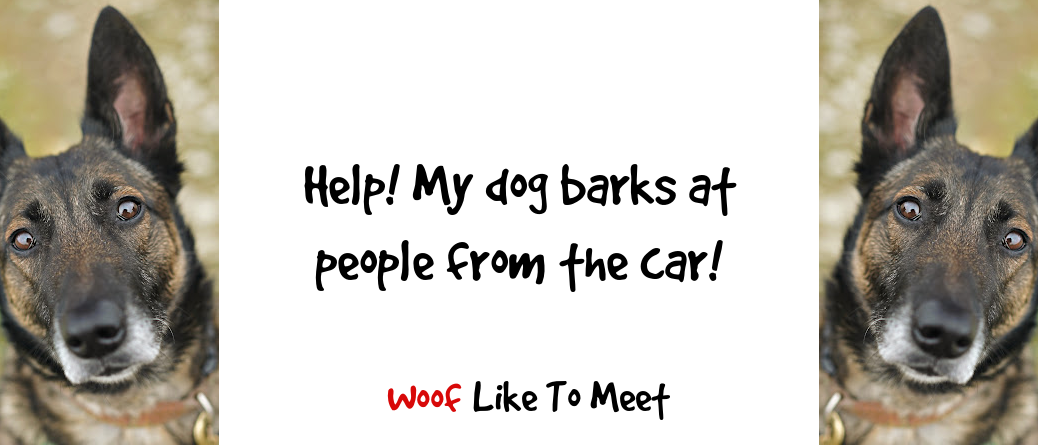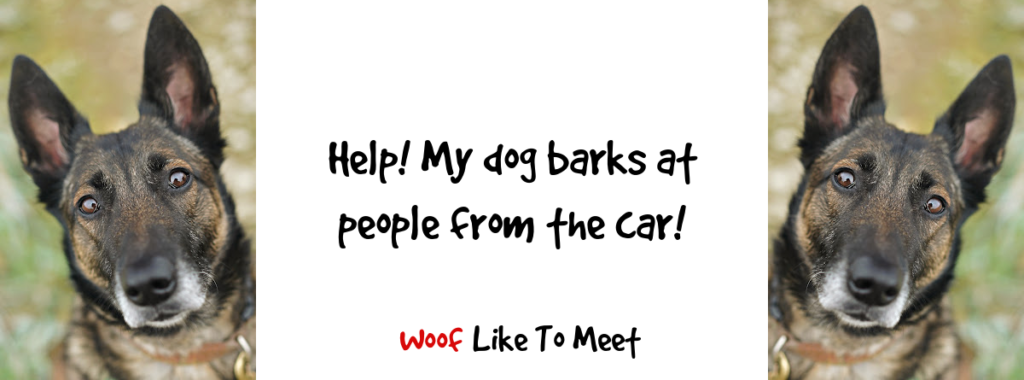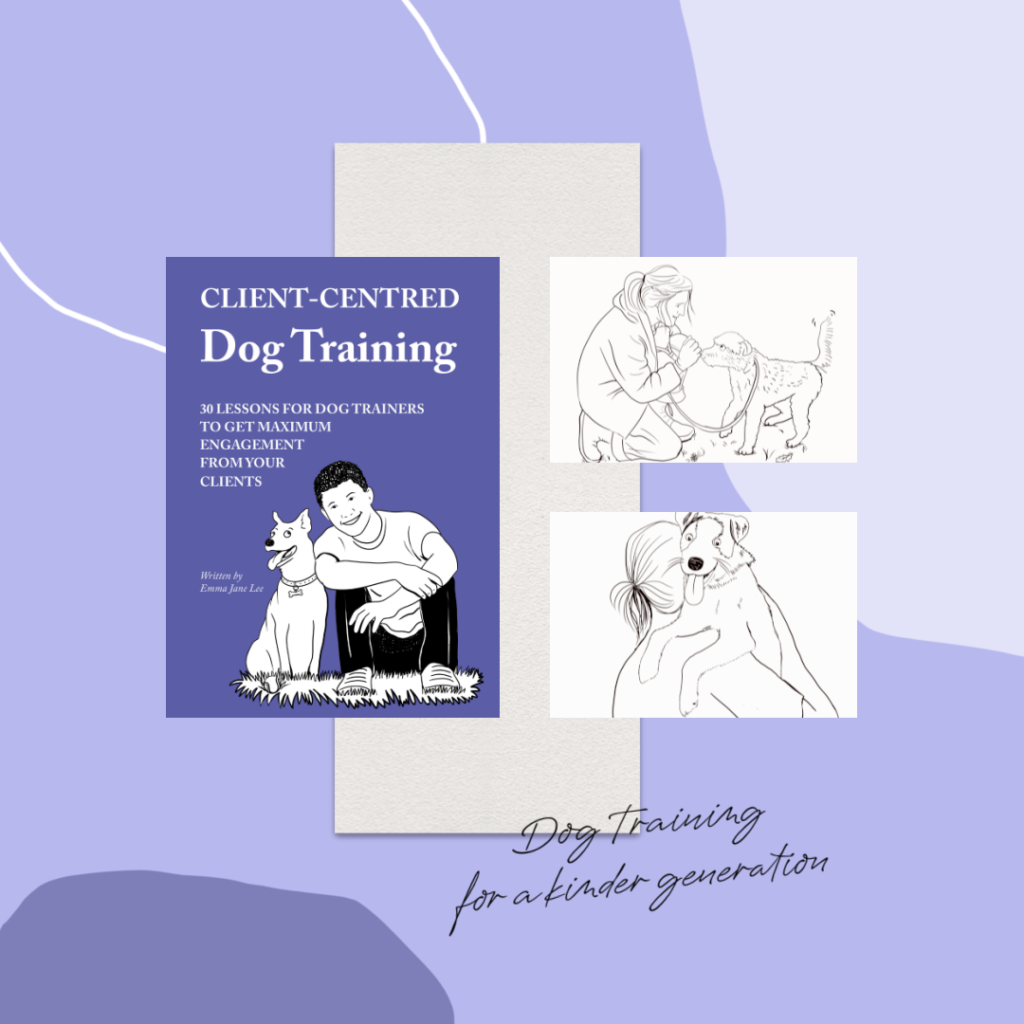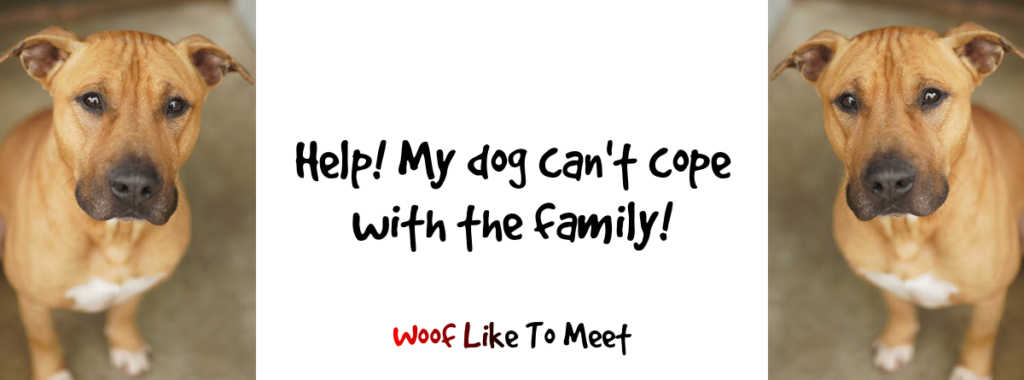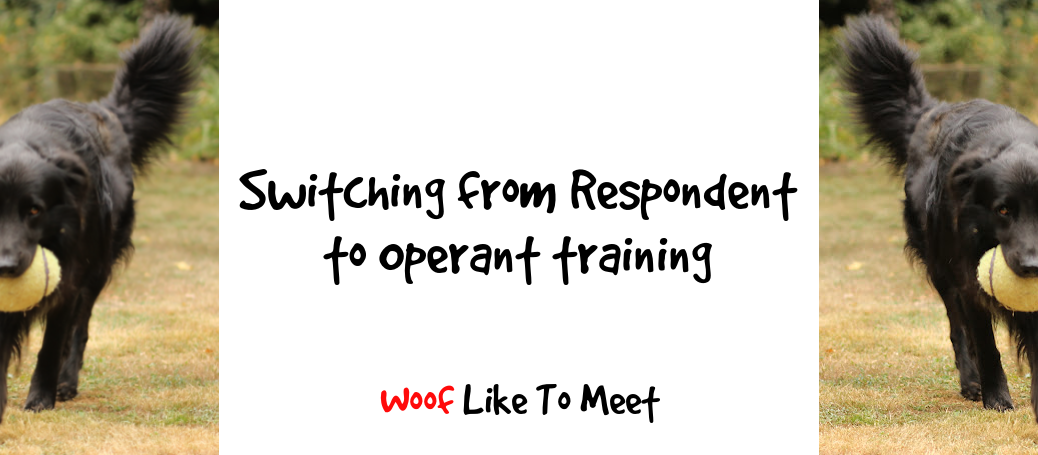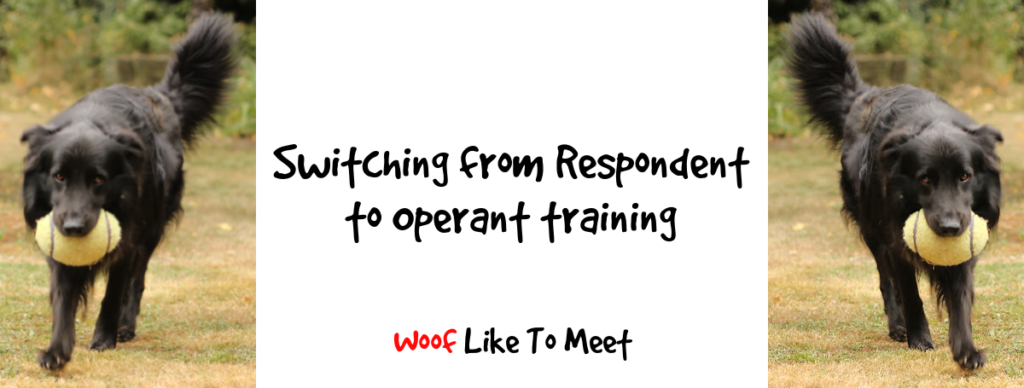Many people contact me to say that their dog struggles to cope with people they see from the car. Sometimes, that can be people the dog sees from a distance, and other times, when the people pass close to the car. It might not just be people who are the problem, but other animals. Dogs might also have problems coping with passing cyclists.
These people, animals or cyclists are what’s known as triggers.
My first question is to ask how the dog usually behaves outside of the car with the same triggers. For instance, both of my dogs have been known to bark at things outside the car when they’re inside. Heston used to struggle hugely with pedestrians and also with cyclists. He still has his moments. Lidy also has hers.
Both of my dogs would bark at certain people or at dogs even if we weren’t in the car. The other morning, we were surprised by a man and his Aussie shepherd at 5.15am. Heston yipped. Lidy glared. We all hurried on our way.
In other words, the car isn’t simply the problem. My dogs struggle with pedestrians and dogs whether we’re in the car or not.
However, when he was young, Heston really, really struggled with pedestrians, cyclists and dogs outside the car. That behaviour was much, much worse than when we were also outside.
If your dogs are barking at pedestrians, at animals or at cyclists when you’re not in the car, then working outside the car will make your life a whole lot easier, I promise.
Other dogs’ behaviour is much worse when they’re in the car. Some guardians tell me that their dog is guarding the car or that they’re guarding them. Nothing is impossible. A quick rule out to make sure it’s exactly this is to set up a camera and video what the dog does if the guardian isn’t present. If the dog still goes nuts, then they aren’t guarding the guardian. If I suspect the dog is guarding the car, a quick rule out is to see how the dog does without the car when people pass at the same distance. And if I suspect that the dog is protecting their guardian as well as the car, then I will test the dog with a pedestrian when the dog is being held by someone other than the guardian and we’re not in the car.
I‘ve never yet found a dog who is actually protecting either the car or the guardian. Even so, it’s a useful rule out to do. One day, I’m sure I will find that.
Often, what I find is that in actual fact, the dog is likely to bark when they’re in the car or out of it, when the guardian is present or not, and when they’re behind a gate or window. In other words, the car is just one place the dog barks but it’s particularly embarrassing or loud or annoying.
And, like Heston, it may actually be louder, more frequent or more easily triggered if they’re in the car. I mean he’d go absolutely nuts at cyclists and passers by and it became very difficult to work with him.
Sometimes, if I’m working with a dog who does bark and lunge at people, dogs or cyclists, the place where the dog lives is so full of triggers that we need to get the dog in the car just to drive somewhere quieter in order to do a little bit of work at least.
It’s not just protective behaviour that you will need to rule out. You’ll also need to rule out how the dog feels in the car. Many dogs are anxious in the car and often, seeing triggers that scare them tips them over the edge. In other words, if your dog doesn’t normally bark outside the car, but they do when they’re in it, you may actually have a dog who’s nervous of the car and you may need to start on that first. A good behaviour consultant will help you identify the exact nature of your problem and give you a protocol to help your dog feel better in the car.
It’s also really important to understand what your dog is doing. That will mean understanding any vocalisations such as barking. Heston has two barks: the excited yip and the angry, lower pitched ‘back away!’ bark. Lidy only has one: the ‘back away’ angry bark.
Heston’s excited yips tell an interesting story. The car is very exciting to him. More exciting than anything else on the entire planet because it means walks. Thus, he’s amped up before I even put him in the car, and it doesn’t take quite as much to set him off.
Say, for instance, he could cope with seeing a person walking a dog at 50m when we’re just on a walk from the house, seeing a dog and person walking at 200m when we’re in the car would be much more likely to make him bark because he’s more excitable in the first place.
He’s not, however, yipping all the time. Sometimes, he’ll give a very cross bark indeed, but that’s very rare. Mostly, he’s excited. He’s more excited because he’s in the car, and then there’s yipping when other stuff goes by where normally, he wouldn’t be likely to.
The car worsens his behaviour.
Lidy actually copes much, much better when she’s in the car. I mean, she did bark at the Eurotunnel guys walking past, but we’d been driving ten hours. She can usually cope in car parks even if people or dogs walk right past us. In fact, the car has been a really useful way to work with her because she seems to feel safer in the car. She’s right. She is safer.
The car improves her behaviour.
In a way, it doesn’t particularly matter whether it’s excitement, fear or anger, though it might slightly affect the kind of work you do. For instance, you may choose desensitisation over respondent counterconditioning with food if your dog is more excited. You can read here about how I choose which method to use. What it won’t affect, however, is your need to go gradually and to build up slowly. That’s the same for all training you’ll do.
If you’ve got a barker who responds to noise in the home and alerts you to every passerby like some kind of furry motion sensor and burglar alarm, starting with my protocol to reduce alert and alarm barking will really help. Simply put, if you’ve done that and it works in the house, then it’ll work in the car too, though you’ll still need to work at a distance and you may need to increase the value of your food for a while.
A ‘Thank you!’ is all it takes now for my dogs to stop barking completely. I did nothing other than teach them to stop when I asked in the home and garden. We then took it on the road for walks. Then we trialled it in a careful setup in the car. One simple cue, ‘thank you!’ and all my noise problems are dealt with.
Even so, there are some other steps you will need to take.
#1 Management
If your dog is barking at anyone they see, then you can’t keep driving down the high street every day hoping they’ll get better. When you’re training, you’re going to need to make sure that your dog doesn’t keep practising the barking or lunging.
One way to do that is to put a crate in the car and then cover it with blankets. You can also put up screens and even put up blackout fabric as long as you stay legal as far as road safety is concerned.
However, crate training may be more challenging than simply training your dog not to bark, so if your dog isn’t used to a car crate and you’re struggling to train them to go in, don’t worry.
You will need to make sure, however, that your dog is safe and appropriately restrained. I watched a car drive through the village the other day with a huge Newfie with his head sticking out of the car window. Cute he may have looked. Having the time of his life, he definitely was. Safe, he wasn’t. A truck came along and on the narrow road, that huge dog nearly had his head taken off. You may still find that sticking up sunscreens and clever use of fabric can make it much more difficult for your dog to see triggers they’re not capable of coping with. Yet.
Management isn’t forever.
But don’t expect your dog to change if you keep putting them in the same situation over and over.
If you need to drive down a busy high street, leave the dog at home. Get a sitter. If you’re struggling with separation-related behaviour, that might make you need to take your dog with you on the drive, but with so many businesses offering delivery, you might need to stop taking your dog out until you’ve dealt with the separation issues first.
Of course you may have a dog with separation-related issues AND barking issues who can’t be left with a sitter if they can’t cope with other people easily… it happens. Again, for a short time, reducing the number of compulsory journeys you need to make will help you manage until you’re ready. Living with an epileptic dog who I don’t leave alone has its challenges if I’m trying to restrict myself to journeys where I know he won’t get to practise barking, but going out at off-peak times can make life much easier. In other words, should I need to take my dog in the car and I can’t block out what they can see, going out when there are fewer triggers around definitely helps.
#2 Plan
You’re going to need to be able to park up for five minutes where there is a steady but intermittent flow of triggers. Let’s use dogs as an example, imagining my dog is barking at other dogs outside the car.
This sounds easier than it actually is. Firstly, you need to go to a place where you can get there without setting your dog off. Secondly, you need a steady but intermittent stream of triggers. For instance, parking opposite the canicross meeting point is not intermittent: there are dogs everywhere for about thirty minutes, all barking and going nuts themselves. On the other hand, parking near the local park, I might wait two hours and not actually see anyone walking a dog.
So you need venues.
You also need a gap between triggers. If it’s just dog-dog-dog-dog-dog, there’s no way for your dog to learn to connect what you’re going to do next with the appearance of the trigger.
I’m a big fan of several places: industrial parks and off-peak very large supermarket car parks if my dog barks at people; across the road from groomers or vets if my dog is barking at dogs.
You need to have a few venues, because the last thing you want your dog learning is a very strong connection to that single place. You want them to understand that what you’re going to do works in all places.
So plan for your venues. Do a reconnaissance trip. Scope it out at the time you plan on doing the training. Park up for five minutes. Count the number of triggers you see. Note within those five minutes at what point the triggers arrive and leave. Ideally, you don’t want them in view for longer than three or four seconds, but that’s not always possible. I have used other parked cars as a way of blocking out some of the view, using a vista rather than a panorama, so that can help.
My tally might look like this:
0.08 man and dog arrive
0.14 man and dog enter clinic
1.17 woman and two dogs leave clinic
1.47 woman and dogs get in car
2.30 man and dog arrive
2.50 man and dog enter clinic
4.00 woman, child and dog leave clinic
4.38 man, woman and dog arrive
4.59 man, woman and dog enter clinic
5.17 woman, child and dog get in car
This would be a perfect time to do some work with my dog, except I may find we’re a bit near, or I don’t have choice to park where I need to, and another morning, it’s simply a dribble of one or two people with cat carriers over a 15-minute period.
Reconnaissance is everything. I ask my vet when they’re doing vaccine clinics, as they tend to do a lot of dogs in a short time. I also check for days when they’ve got three vets on. There’s no point going on a day when they’ve got one vet doing nothing but pre-planned surgery.
If the worst comes to the worst, I’ll even enlist my friends as well-timed accomplices, arrange a meet-up time, ask them to move at very specific times and avoid a pile-up, and make sure it’s as controlled as I can make it. The better I plan, the more clear it’ll be for the dog. The more successful the first time, the better it’ll be after. That’s not to say you can’t do it anyway – just that less clean setups tend to lead to less clean results. It can be overwhelming and confusing for the dog.
You also need to find the ‘Goldilocks’ spot: safe parking at a distance from the trigger where your dog can see the trigger but the trigger isn’t that close that you’re going to end up with a barkfest. You need the trigger to be noticeable. What you’re going to do in #4 needs your dog to be aware that there is a pedestrian, dog or cyclist present. At the same time, you also need to be far enough away that you don’t trigger your dog’s barking. For me, that’s the back of the supermarket car park if I’m working with dogs whose barking is triggered by people – and the other side of the road from the vet clinic if I’m working with dogs whose barking is triggered by dogs. Narrowing the vista can definitely help if you have little choice but to be too close.
#3 Secure your delivery system
Obviously, you’re going to start the work when you’re static, unless you’ve got an accomplice who can feed treats to your dog. If you’ve got someone who can do this, that is genius. However, it’s going to be important to fade those people out if you ever drive alone, because otherwise your dog will learn not to bark at triggers when you have a treat-feeding passenger, and that all other times are fine.
If you’re working with an accomplice, you can of course continue to drive around. Mostly, though, you may find yourself knowing that you’re going to be going it alone and that you don’t have an accomplice, or that eventually, you’re going to be alone and driving when your dog sees someone walking their maltipoo down the high street.
Eventually, you may be forced to deliver treats while you are driving.
This carries enormous risks for safety and legality. All in all, it’s probably not as risky as the distraction it causes if you can’t safely drive past a school without your dog going nuts, but even so, you do need to think about how you can deliver food when you’re on your own in an emergency.
The easiest way is to train a marker.
Markers, like my ‘thank you!’ mean the treat is on its way.
You can’t wait ten minutes from saying ‘thank you!’ to delivering it. Well, not at first. But you can build up to it, especially if you practise in the home. Thus, when my dogs fail to bark at the yappy chihuahuas who pass every morning, and I can say ‘thank you!’ and stretch out the time before I pay up for the non-barking, I can start with it being a simple matter of seconds and build up to being a few minutes. This is one way of helping your dogs learn that if the magic word is said or the clicker sounds, they will get reinforcements.
Marker words definitely help with that and you don’t need hands free for clickers.
Most of the time, you should find yourself doing at least three or four weeks of practise with 3-4 short 5-minute sessions every other day. They’ll start static, where passing a treat over your shoulder would probably work.
However, if you’re not very mobile, if you have a large car, if you have the dog in the crate in the boot, if you can’t actually get a treat from your person to the dog, then you need some other solutions.
One is a secure remote treat dispenser. These are quite cumbersome, but we did use one on top of a crate when the dog was in the boot. The treat dispenser was strapped over the crate at a slight angle. When the remote was pressed by the driver in the front seat, the treat rolled into the crate and all was well. We velcroed the remote to the door panel. Treat delivery made easy. The guardian would press a button and a treat would roll out.
Another guardian had the treat dispenser on a secured box just in front of the dog’s seat. The seat belt harness gave just enough flexibility on a harness that the dog was able to bend forward and get the treat from the bowl that’s part of the treat dispenser into which the treat was delivered.
It doesn’t have to be that high tech or expensive. I bought two plastic plumbing tubes and an angled joint for each. I taped one tube starting from the shoulder rest on the right hand side of the driver’s seat and taped the bottom to the driver’s side rear passenger seat. Then I taped another tube starting from the left hand side of the driver’s seat to the passenger’s side rear seat. I could drop a round treat down the tube and it would be magically delivered to the dogs in the rear. This stayed in place until we’d worked our way through the programme, just for emergencies.
Obviously, I’m not a fan of throwing treats into the back seat. I have two dogs. It’d be a free-for-all. Treats would get lost and within a week, my car would smell of mouldy dog treats.
#4 Train
Once you’ve managed it so your dog doesn’t end up barking when you’re putting training into place, and you’ve planned where and when you’ll do the training, and you’ve decided how best to get treats from you to your dog, then you’re ready to train.
As I said, you need that ‘Goldilocks’ distance. When you have that, all you have to do as soon as the trigger comes into view is mark the response with a marker word, and then deliver food until they go away. Repeat four times more in a very short timeframe (less than five minutes, ideally).
Plan to get closer and closer to the trigger, or to have more and more challenging triggers. Little old dogs toddling into the vet are not a challenge for Heston, but a load of loose scenthounds just before the hunt, or a load of loose huskies and collies before canicross, that’s a challenge. I’d also choose to do it at the end of our walks when he was less excited, and I’d gradually have more trials, more challenge, more dogs and a longer time. Instead of watching five slow people from 200m away for five minutes on a Tuesday lunchtime supermarket visit, we’d end up watching 200 teenagers come bursting out of school right outside the school gates over a ten minute period.
Eventually, as soon as you see your dog notice the trigger (and not bark!) mark it (I say good!) and then feed them.
You can add another word if you like: I say ‘Good job!’ just like I do for any non-barks in the house. It’s what my dogs understand happens when they don’t bark, and the thing they know I say before I give them a treat.
Then the next session, we just get a little closer, a little more challenging.
It’s that simple.
Finish on a win. Never ask more of your dog than they can take. If your dog barks, you’re not back at square one, but you may need to adjust your programme so that it’s less challenging.
The most difficult bits are setting up a delivery system for treats. Using an accomplice is very helpful but you will need to fade them out and pick up the slack unless you never, ever drive your dogs about without a passenger.
It can also be difficult to get those first staging areas set up properly. Get that right, and everything else is easy.
There may be times that you’ll have a bark or two – sometimes there’s just too much to cope with – and that’s fine. That’s life. But I wouldn’t keep putting my dog in that challenging position if they couldn’t cope with it usually. I mean, one or two yips when a team of Tour de France cyclists go past isn’t the end of the world. Telling a Eurotunnel guy to step away from the vehicle when you are very tired is also not the end of the world. But a little bit of training, marking them as soon as they see the trigger then feeding them until the trigger disappears can really help them cope much better with the world passing by outside their window.
If you’re a dog trainer looking for gifts for your friends, my book is out now!

